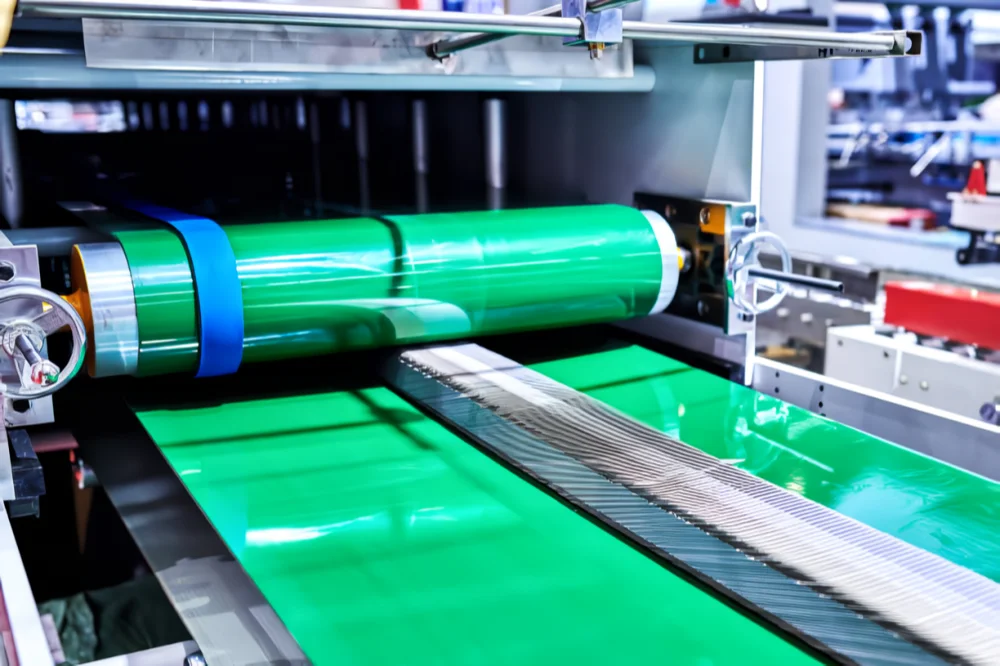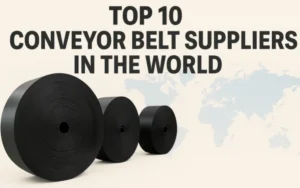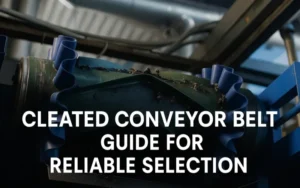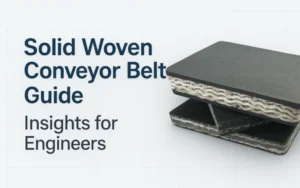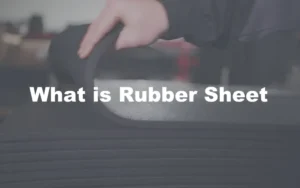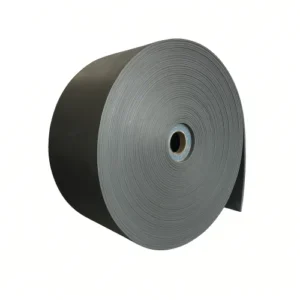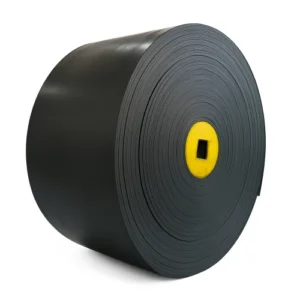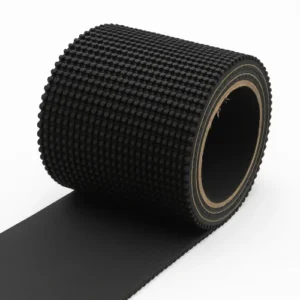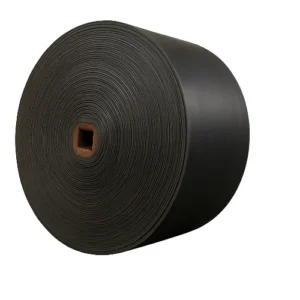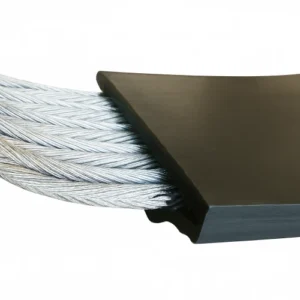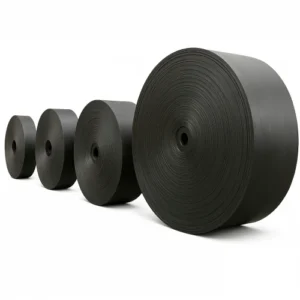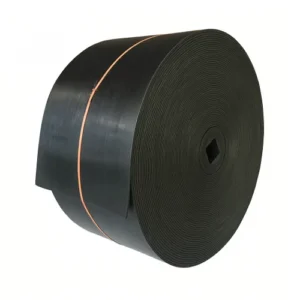Introduction: The core role of conveyor belts in modern industry
The operation of industrial production and logistics systems is like a huge mechanical clock. Each gear must run accurately, and in this system, conveyor belts are undoubtedly a vital part. Conveyor belt types have become the backbone of modern manufacturing and warehousing. Whether it is a busy automobile production line or a fast-paced e-commerce logistics center, these efficient transmission tools are relied on to ensure the smooth flow of materials. With the continuous advancement of automation technology, enterprises’ requirements for conveyor belts are becoming more and more complex. It is not just a simple material transmission, but more about the comprehensive performance of safety, efficiency and adaptability to complex environments.
The earliest conveyor belts appeared in the late 19th century and were mainly used in mining and agriculture to simplify the process of material handling. With the rapid development of science and technology, conveyor belt types have gradually evolved from simple mechanical devices to modern highly automated and modular equipment that can meet various complex industrial needs. Nowadays, the design of conveyor belts has become more diversified according to different industrial applications. Among them, rubber conveyor belts and PVC conveyor belts are the two most common types, which are widely used in multiple industries, from heavy industry to light industry, to meet the material transportation needs of different scenarios.
The introduction of rubber conveyor belts has brought significant efficiency improvements to the heavy industry sector. With its excellent load-bearing capacity and outstanding wear resistance, rubber conveyor belts have been widely used in high-intensity industries such as mining and construction, becoming an ideal choice for heavy material transportation. At the same time, PVC conveyor belts are more used in light industries such as food processing and electronic manufacturing due to their lightness and simple maintenance, meeting the high requirements for hygiene and flexibility.
When choosing a suitable conveyor belt, companies should not only pay attention to the durability of the conveyor belt, but also comprehensively consider industry-specific needs, such as temperature tolerance, the type of conveyed materials, and the safety standards of the working environment. Different conveyor belt types will directly affect the efficiency, safety and overall operating costs of the production line. Reasonable selection of conveyor belts can not only optimize the production process, but also reduce equipment maintenance costs and ensure the continuous and efficient operation of the production line.
In heavy-duty industries, rubber conveyor belts are an ideal choice because they can handle high-strength, rough materials and have excellent wear resistance; in the food industry, which has strict hygiene standards, PVC conveyor belts have become the main equipment of the conveyor system due to their lightness and easy cleaning.
Through a deep understanding of various conveyor belt types, companies can choose the right conveyor belt type according to their own needs and optimize the overall performance of the production line.
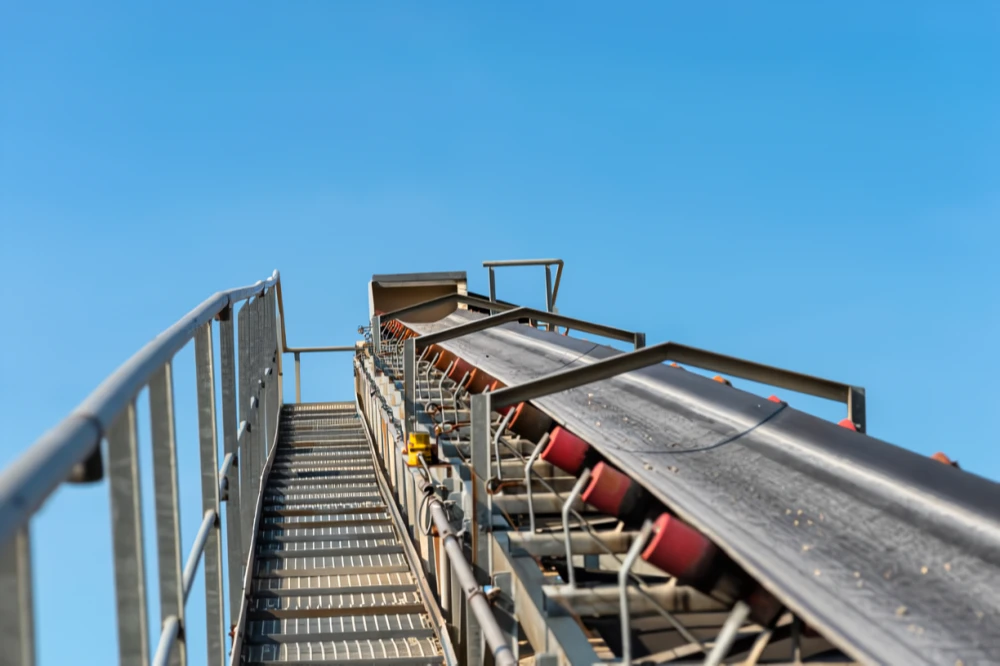
Rubber conveyor belts: A reliable choice for heavy-duty industries
Rubber conveyor belts dominate industrial applications due to their superior durability and high strength, especially in areas that require heavy-duty material transportation, such as mining and construction. They can not only withstand the test of extreme environments, but also maintain stable performance for a long time.
Advantages of rubber conveyor belts
Rubber conveyor belts have been widely used in heavy industrial fields due to their excellent tensile properties. In the mining industry, materials such as ores need to be transported over long distances and are extremely heavy. The high strength of rubber materials enables conveyor belts to withstand huge tensile forces and maintain stable operation in this environment. At the same time, it can effectively prevent breakage or deformation due to overload, which is essential for production lines that need to operate continuously.
Not only that, the wear resistance of rubber conveyor belts is also very outstanding, especially when dealing with rough materials such as sand, gravel, and minerals. Friction and impact are inevitable problems in the conveying process, and the wear resistance of rubber materials can effectively reduce the wear caused by these frictions and extend the service life of the equipment. Under long-term and frequent operation, rubber belts can still maintain a good use state, greatly reducing the frequency of downtime maintenance.
In addition, rubber conveyor belts perform particularly well in high-temperature operations. The metallurgical industry needs to transmit high-temperature metals and ores, and rubber belts can withstand ambient temperatures up to 200°C to ensure that they are not deformed or damaged in high-temperature operations. Because of this, rubber conveyor belts are often used in high-temperature environments such as metallurgy and steel to help companies maintain continuous and efficient operation of production lines.
Although rubber conveyor belts have many advantages in the heavy industry field, they also have some limitations. First, the manufacturing and installation costs of rubber conveyor belts are relatively high, especially for special models used in high-temperature or corrosive environments, which require a large initial investment. Although the long-term performance of rubber belts can bring lower maintenance costs, companies still need to consider this in their initial budgets.
Secondly, rubber conveyor belts are heavier, and the transportation and installation process requires more manpower, which may increase the company’s operating costs. In contrast, lightweight conveyor belt types (such as PVC conveyor belts) are more convenient in installation and replacement, which is especially attractive for small and medium-sized enterprises.
In extremely low temperature environments, rubber materials may become brittle, resulting in a decrease in the durability of the conveyor belt and affecting its normal operating performance. For extremely cold working environments, companies may need to consider using other materials that are more adaptable to low temperatures. This requires companies to not only pay attention to materials and workloads when choosing conveyor belt types, but also make reasonable decisions based on environmental conditions.
Application scenario expansion
Rubber conveyor belts are widely used in heavy-duty industries such as mining, metallurgy, and construction. In addition to these fields, rubber conveyor belts also perform well in other specific fields. For example, in the cement industry, when conveying large amounts of concrete, stone and other building materials, the durability and wear resistance of rubber belts enable them to easily cope with large-volume, heavy-load material transmission needs.
In logistics centers, rubber conveyor belts are also used to carry heavier packaging and transportation needs. Although this scenario requires high speed, the strength of the rubber belt ensures that there will be no excessive wear under high-load operation. Therefore, it provides stable support for the logistics and distribution industries.
Environment and the future development of rubber conveyor belts
As environmental regulations become increasingly stringent, the manufacturing technology of rubber conveyor belts is also constantly improving. Some manufacturers have begun to develop recyclable rubber materials and degradable products to reduce the impact on the environment during the production process. These innovations will bring new opportunities to the conveyor belt industry, and also help companies continue to use efficient rubber conveyor belts while complying with environmental regulations.
The future development of rubber conveyor belts is not only reflected in the environmental friendliness of the material, but also in the further improvement of its performance. By optimizing the manufacturing process, future rubber conveyor belts may show better adaptability and longer service life in harsher environments.
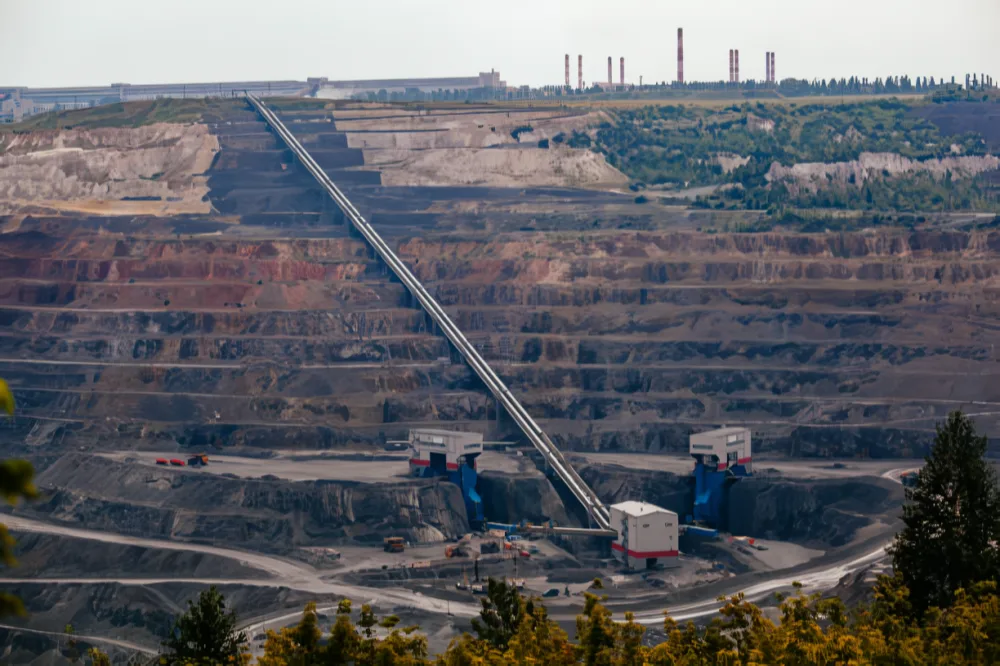
PVC conveyor belts: a lightweight and flexible universal solution
As an indispensable transmission equipment in modern light industry, PVC conveyor belts occupy an important position in many industries with their lightness, flexibility and easy maintenance. Compared with rubber conveyor belts used in heavy-duty industries, PVC conveyor belts are mainly used in industries that are weight-sensitive and have strict requirements on cleanliness, such as food processing, electronic manufacturing and pharmaceutical industries. They not only perform well in the transmission of lightweight materials, but also adapt to complex and changing working environments.
Advantages of PVC conveyor belts
Lightness is one of the biggest advantages of PVC conveyor belts. During installation and maintenance, PVC belts are lighter and can be deployed quickly, reducing downtime. This lightness not only reduces the operating costs of enterprises, but also improves production efficiency, especially in small and medium-sized enterprises or factories that need to frequently adjust production lines.
Easy cleaning and grease resistance make PVC conveyor belts shine in the fields of food processing and medicine. Because PVC materials have good resistance to grease, chemicals and moisture, especially when conveying food or medicines, they can ensure hygienic safety and meet strict hygiene standards. This makes it a mainstream choice in the food processing industry, especially in working environments that require high cleanliness, such as meat and bread. PVC conveyor belts ensure efficient transmission operations with their easy-to-clean characteristics.
And the initial cost of PVC conveyor belts is low, which is also one of the reasons for its popularity. Compared with rubber conveyor belts, the manufacturing and installation costs of PVC belts are relatively low, especially for companies with tight budgets, PVC conveyor belts have become a very cost-effective choice. Its durability is also sufficient to cope with daily production needs in light-load industries, thereby reducing initial investment while maintaining efficient working performance.
Limitations of PVC conveyor belts
Although PVC conveyor belts have significant advantages, their performance in certain extreme environments is limited. First, poor high temperature resistance is a major weakness of PVC materials. In high temperature environments, PVC conveyor belts are prone to softening or deformation, so they are not suitable for high-temperature industries (such as metallurgy or steel production). For this type of high-temperature operation, companies usually choose rubber or other heat-resistant material conveyor belts.
Secondly, the load-bearing capacity is limited. PVC conveyor belts are suitable for light or medium-load material transmission, but when facing heavy or sharp materials, its tensile strength and wear resistance are far inferior to rubber belts. This means that PVC belts may be more susceptible to wear and tear and have a shorter service life when handling rough materials. Therefore, in scenarios where high-strength materials need to be transmitted, companies usually prefer more durable rubber conveyor belts.
Typical application scenarios
The food processing industry is one of the most common application areas for PVC conveyor belts. In the transmission process of foods such as meat, bread and fruit, the anti-grease and easy-to-clean properties of PVC materials make it the best choice to ensure production hygiene and safety. Food processing workshops have extremely strict requirements on the hygiene of equipment, and PVC conveyor belts can easily cope with the requirements of cleaning and disinfection while ensuring efficient production.
The electronics manufacturing industry also uses a large number of PVC conveyor belts, especially when transmitting sensitive electronic components. Since electronic products are extremely sensitive to static electricity, the anti-static properties of PVC materials can effectively prevent static electricity accumulation and ensure the safety of electronic components during the production process. This is particularly important in precision electronics manufacturing, especially in production lines that require high-speed transmission. PVC conveyor belts have been widely used for their flexible and precise material transmission functions.
The high requirements of the pharmaceutical industry for a sanitary environment make PVC conveyor belts an ideal choice for drug packaging and transportation. It provides a clean transmission environment to ensure that drugs are not contaminated during production and packaging. By using PVC conveyor belts, pharmaceutical companies not only improve production efficiency, but also ensure the safety and compliance of product quality.
PVC conveyor belts play an important role in many light industrial fields due to their light, flexible and economical characteristics. Although its application is limited in heavy loads and high temperature environments, for those industries that focus on hygiene, safety and cost control, PVC conveyor belts are undoubtedly an efficient and economical solution.

Rubber conveyor belt vs. PVC conveyor belt: How to choose?
In industrial production, conveyor belt types are key equipment that affect production efficiency, safety and cost-effectiveness. Rubber conveyor belts and PVC conveyor belts are two widely used conveyor belt types, each with different advantages and suitable for different industry needs. Enterprises need to evaluate according to specific application scenarios when choosing.
Choose according to industry needs
Rubber conveyor belts are particularly suitable for heavy loads, high temperatures and harsh environments. For example, industries such as mining and metallurgy have high requirements for the wear resistance and tensile strength of transmission equipment, while rubber conveyor belts have excellent tear resistance and durability. According to data, the load capacity of rubber conveyor belts can reach 20 to 50 tons/hour and can maintain a service life of 5 to 10 years in harsh environments. Its high tensile strength and wear resistance make it suitable for transporting sharp, rough and heavy materials.
In contrast, PVC conveyor belts are more suitable for light-load applications such as food processing, electronics manufacturing and pharmaceutical industries. PVC conveyor belts have a load capacity of 2 to 10 tons/hour and are often used in industries that require high hygiene and cleanliness due to their anti-static, anti-grease and chemical corrosion resistance. Although they are not as durable as rubber belts, with a typical service life of 2 to 4 years, their lightness and easy maintenance save companies installation and maintenance costs.
Cost-benefit analysis
From a cost perspective, rubber conveyor belts have a higher initial investment, usually priced at $40 to $80 per meter, but their long service life and high durability make up for the disadvantages of higher initial costs. In the long run, rubber belts can reduce the frequency of replacement and maintenance, making them the first choice for handling heavy loads and high-intensity working environments.
In contrast, PVC conveyor belts have a lower initial cost, priced at about $20 to $50 per meter, which is suitable for companies with limited budgets. However, it should be noted that PVC belts are more susceptible to damage in high-load and high-wear working environments, and usually need to be replaced every 2 to 3 years, and the long-term maintenance cost may be high.
Temperature and chemical resistance
Temperature and chemical resistance are important considerations when choosing conveyor belt types. Rubber conveyor belts have excellent high temperature resistance and can operate in environments up to 200°C. In addition, rubber materials also have strong corrosion resistance to chemicals such as acids and alkalis, making them excellent in high temperature and corrosive environments such as metallurgy and steel.
PVC conveyor belts are limited in temperature control and can usually maintain performance below 60°C, but tend to soften or deform above this temperature. However, PVC materials perform well when handling chemicals, greases and other substances, so they are widely used in industries such as food processing, pharmaceuticals and electronic manufacturing.
Application scenarios
Rubber conveyor belts: Suitable for heavy-duty, high-temperature, harsh environments such as mining, metallurgy, and steel. Its high wear resistance and tear resistance enable it to cope with the transportation needs of sharp and rough materials.
PVC conveyor belts: suitable for light industries such as food processing, electronic manufacturing and pharmaceutical industries, with the advantages of being light, easy to install and easy to clean, suitable for occasions with high requirements for cleanliness and anti-static.
Ultimately, when companies choose rubber conveyor belts or PVC conveyor belts, they should make decisions based on actual industry needs, temperature environment and long-term maintenance costs. Choosing the right conveyor belt types will improve production efficiency, reduce maintenance costs, and ensure stable operation of the production line.
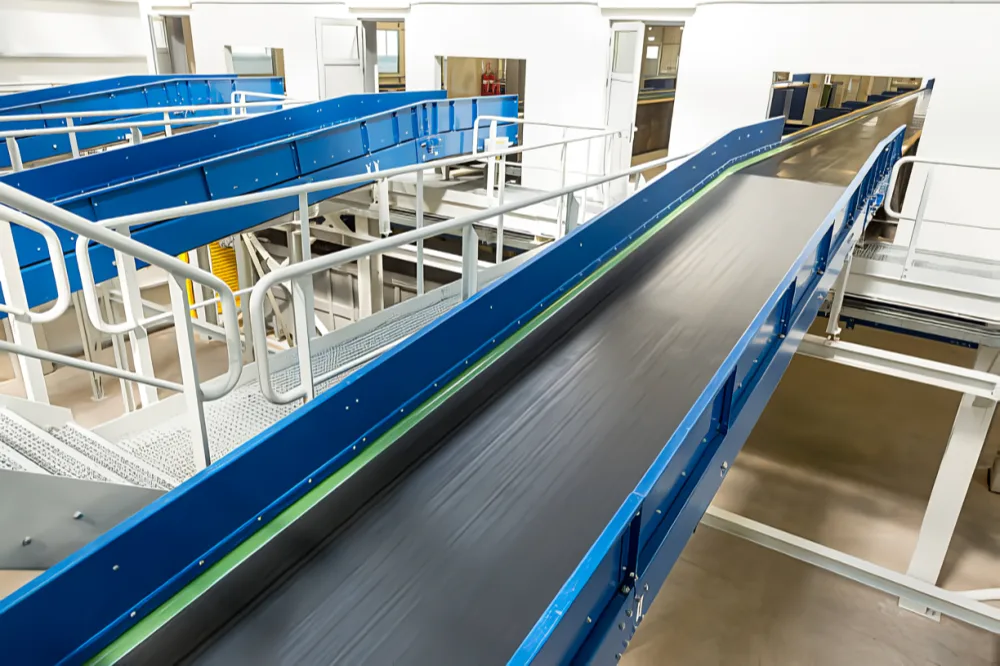
Final decision on rubber vs. PVC conveyor belts
In industrial production, choosing the right conveyor belt types is crucial to improving production efficiency, reducing maintenance costs and ensuring equipment safety. A comprehensive analysis of rubber conveyor belts and PVC conveyor belts shows that each conveyor belt has its own unique advantages and applicable scenarios.
Rubber conveyor belts are very suitable for heavy industrial applications with high loads and harsh environments due to their excellent resistance to high temperatures, wear and tear. Their high strength and long life make them excellent in industries such as mining, steel and metallurgy, and their long-term maintenance costs are low despite the high initial investment.
In contrast, PVC conveyor belts are more suitable for light industrial applications such as food processing, electronic manufacturing and medicine due to their lightness, low cost and easy cleaning. They have a lower initial cost, but due to their weaker wear resistance and tensile strength, they are suitable for industries with high requirements for cleanliness and lighter loads.
Ultimately, companies should make a comprehensive assessment of rubber conveyor belts or PVC conveyor belts based on actual industry needs, temperature environment, material types, and long-term cost-effectiveness. Each type of conveyor belt has its own unique advantages and limitations. Choosing the right equipment can not only ensure the continuity of the production process, but also save the company a lot of operating costs in the long run.

